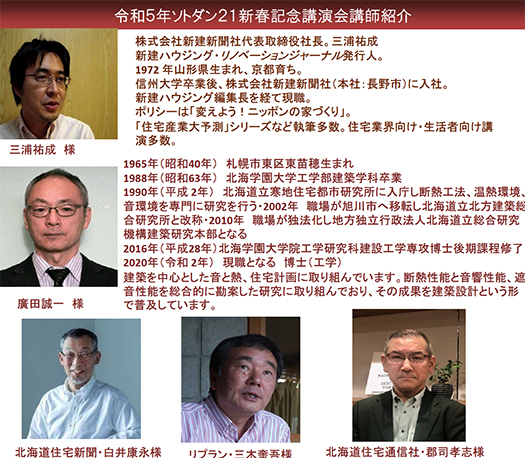
Replan誌の編集長を交代したこと、また情報交流のリアルな機会がほとんどなかったこともあって、住宅関係団体での意見交換や情報発信機会はわたし自身減少していました。ソトダン21は断熱材メーカー・アキレスさんが運営中核を担っている業界団体。北海道では新住協やアース21といった工務店グループによる情報交流活動が中心で、こうした断熱材メーカーさんがバックアップする会は珍しい。昨年も話す機会がありましたがZOOM形式。ことしは久しぶりのリアル開催です。参加者はリアルで50人ほどでZOOMでも公開されていたと言うこと。広い会場でお互いの席を離しながらの2類感染症対応形式でした。自由な情報交換環境までまだしばらく時間はかかるようですね。
さてポスター写真のような講演者の末尾にお話しさせていただきました。わたしどもはユーザーの「いい家」志向に対応した住宅の「ソフト」部分に注力しているメディア企業。なのでいわゆる業界的な情報については各社の情報を受け止めながら、ユーザーの情報支援サービス・弊社新事業のAI活用型システム「Replan住まいナビ」について紹介し背景説明など情報発信しました。新建の三浦氏や他の業界メディア企業さまなどから強い興味を示していただきました。
今回のイベントの中心的な話題はやはり太陽光発電についての論議だったと思います。基調講演的に北総研の廣田氏による「北方型住宅ZERO」の説明。当初の原案では「北方型ZEH」という志向性から諮問委員会での多くの参加者の意見を反映し、基本性格が脱炭素のさまざまな手法をそれぞれ「ポイント化」して、地域特性に合わせてユーザーと作り手が手法を主体的に選択するという方向性が示された。わたしも論議のプロセスに関与しているので納得できる方向性だと思っています。その点について北海道内でも太陽光発電を積極的に推進している企業からの発言などがありました。
結論としてはこのテーマについては北海道全域で各社、その対応先の住宅ユーザーも、それぞれの気候特性を反映して「まだら」模様での対応ぶりが浮き彫りになったと思います。
東京都はPV「義務化」に舵を切った。太平洋側温暖地域での選択としては理解できる一方、日本海側気候特性が人口的に多数派の北海道としては、やはり違う対応になるのは常識的。とくに今年の冬は日本海側地域の多雪気候特性が顕著に体感された。道路渋滞でEVへの懸念が顕在化してきているなかで家庭エネルギー源をPV一本足で追究することの不安定さが広く認識されたのが事実。北海道のように広域移動手段が重要な地域で将来的選択と一般に言われるEV車種についてはまだ懸念は強く、そのエネルギー源として冬場はほぼ発電しないPVに依存すべきかどうか、ユーザーも迷い、建築事業者もまた足を踏み出しにくい状況なのだと思います。ことは住宅設備選択に直結する課題。
さて今週は本日、北海道の住宅施策検討委員会、そしてそのメディア向け発表があります。あすにはこの動向についての弊社の独自取材、そして2/3には「北海道×工務店」によるZOOM意見交換会などの動きがあります。ようやくにして感染症5類対応の社会がスタートする予感があります。
English version⬇
1/30 Real Information Exchange at Sotodan 21 New Year Lecture Meeting
The central theme is the next generation home energy choice issue. The direction of the point system and choice system for northern-style housing ZERO in contrast to Tokyo’s PV mandate. ・・・・.
Due to the change of editor-in-chief of Replan magazine and the lack of real opportunities for information exchange, my own opportunities to exchange opinions and disseminate information in housing-related organizations have been declining. Sotodan 21 is an industry organization run by Achilles, a manufacturer of insulation materials. In Hokkaido, information exchange activities are mainly carried out by construction firm groups such as Shinjyukyo and Earth 21, so it is rare to find an association backed by a manufacturer of insulation materials like this. Last year, I had the opportunity to speak at a ZOOM meeting, but it was in a ZOOM format. This year, for the first time in a long time, the meeting will be held in person. About 50 people attended the real event, which was also open to the public via ZOOM. It was a large venue, and the participants were seated apart from each other in a class 2 infection response style. It seems it will be a while before we have a free information exchange environment.
Now, I spoke at the end of the speaker’s speech as shown in the poster photo. We are a media company that focuses on the “software” of housing to meet the “good house” needs of our users. Therefore, while accepting information from other companies on so-called industry information, I introduced and explained the background of our new business, “Replan Sumai Navi,” a user information support service and our AI-based system. We received strong interest from Mr. Miura of Shinken and other industry media companies.
The main topic of the event was the discussion on solar power generation. Mr. Hirota of the North Research Institute gave a keynote presentation on “Northern Style Housing ZERO. The initial draft of the plan was oriented towards “Northern-style ZEH,” and reflecting the opinions of many participants in the Advisory Committee, the basic character of the plan was to “point” various methods of decarbonization, and to allow users and builders to independently select methods in accordance with regional characteristics. As I was involved in the discussion process, I think this is a direction that makes sense to me. In this regard, there were comments from companies that are actively promoting solar power generation in Hokkaido.
In conclusion, I think that this theme has highlighted the “uneven” response of companies and residential users throughout Hokkaido, reflecting the different climatic characteristics of each region.
The Tokyo Metropolitan Government has taken the helm in making PV “mandatory. While this is an understandable choice for warmer regions on the Pacific Ocean side, it is common sense that Hokkaido, which has a majority population with Japan Sea side climate characteristics, would respond differently. This winter, in particular, the Japan Sea side region’s heavy snowfall climate characteristics were clearly felt. With concerns about EVs becoming more apparent due to road congestion, it is true that the instability of pursuing a single leg of PV as a household energy source has been widely recognized. In areas like Hokkaido, where wide-area transportation is important, there are still strong concerns about EVs, which are generally considered the future choice, and users are unsure whether they should rely on PV, which generates almost no electricity in winter, as their energy source. This is an issue that is directly related to the choice of housing equipment.
This week, today, we have the Hokkaido Housing Policy Review Committee and its announcement to the media. We will be doing our own coverage of this trend tomorrow, and on February 3, there will be a ZOOM opinion exchange meeting by “Hokkaido x Koumanten” and other activities. I have a feeling that we will finally see the start of a society that can cope with Class 5 infectious diseases.
Posted on 1月 31st, 2023 by 三木 奎吾
Filed under: 住宅性能・設備







コメントを投稿
「※誹謗中傷や、悪意のある書き込み、営利目的などのコメントを防ぐために、投稿された全てのコメントは一時的に保留されますのでご了承ください。」
You must be logged in to post a comment.